Picture heavy - My butter making process for the newbies
Oct 31, 2013 20:02:00 GMT -5
ajplmama, rosalind, and 3 more like this
Post by dmbenson on Oct 31, 2013 20:02:00 GMT -5
So When I finally started milking Bisco, I knew I wanted to make butter first thing - but ran into a wee small problem actually finding out HOW - I mean other than "shake or mix cream until it breaks (huh?) and then rinse, roll and package".  All very good and well, but what does it LOOK like? Exactly what do I look for? What do I use? You know, all the questions that those who've been doing it for years and years have even forgotten they know because it's automatic for them.
All very good and well, but what does it LOOK like? Exactly what do I look for? What do I use? You know, all the questions that those who've been doing it for years and years have even forgotten they know because it's automatic for them. 
So I thought I'd just do a quick pictorial on what I do - it's certainly not the only way - and probably not the best way, but it works for me, I have lots of lovely butter, and just maybe someone who's just now venturing into the mysteries of cows/milk and butter making can benefit. That's my hope anyway.
So, You've milked your cow, and have cream. I personally have found that I can't make butter in the summer - it's just too warm in my house. It also works better for me if the cream is a couple of days old - which works for me since it takes about 4 days to get a gallon of cream. I just let it sit on the counter for half the day, or overnight, or some equivalent quantity of time. It's actually cool enough in my kitchen that I can leave it out for a couple of days in the fall/winter and it's still sweet. Some people like it to culture for several days - I haven't tried that yet.
So, the cream:
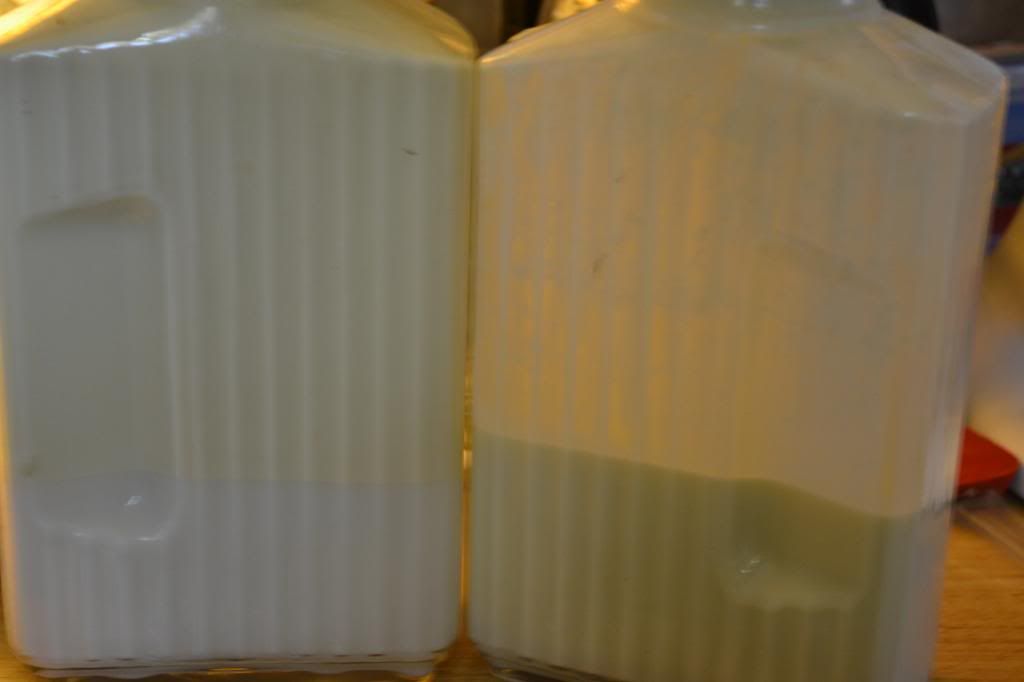
I just skim into these half gallon containers every day until they're full and then start the next one. I make butter when I have about a gallon worth of cream.
I tried making butter in my Kitchenaid stand mixer. I really did. Complete with tea towel over the top. Over half the time I couldn't get the cream to break - and when I did it went everywhere - the walls, the counter, the mixer, the floor. The dogs used to love it when I made butter. Me, not so much. So I switched to the blender. Eureka!

I only fill it about half full at a time. With this size blender, I make 3 batches out of a half a gallon of cream. I blend it on the lowest setting until it breaks. If it's not too noisy in your kitchen, you can actually hear the sound of the mixer change when it happens. It takes between 5 and 10 (usually closer to 5) minutes to break. If it doesn't seem to want to, you can add a dollop (I know - such a technical term ) of ice water into the blender. This is what it looks like when it breaks.
) of ice water into the blender. This is what it looks like when it breaks.
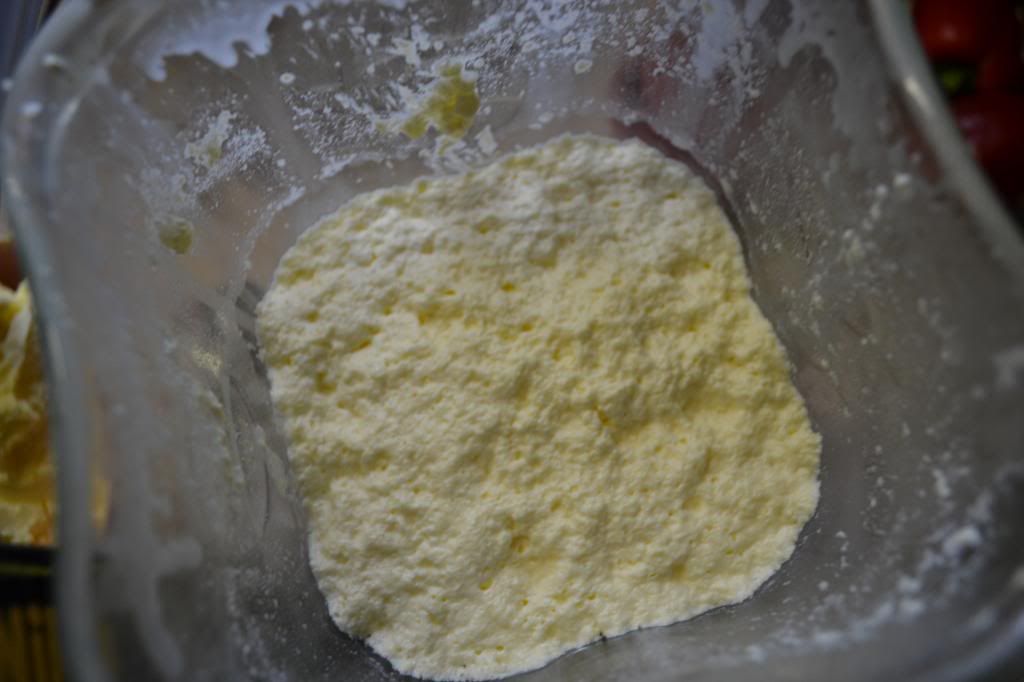
Doesn't look much like butter does it? but wait.....
Once it's broken carefully pour off as much of the buttermilk as you can - don't worry if you can't get it all out. There are, I suppose all sorts of fancy ways to do it, but I either use the lid or my hand to hold the butter back while I'm pouring. I then dump the butter into the bowl of my stand mixer. I add (and this is really important) a couple of cups of ice water. Not cold water, not refrigerated water, but water that's actually had ice cubes added to it. I don't put the cubes in however! I put it on the mixer with the paddle attachment and turn it on low speed for a couple of minutes. Don't however, when you go to turn it off, do what I did just today, and go the wrong way with the switch or your dog's will love you again - I promise .
.
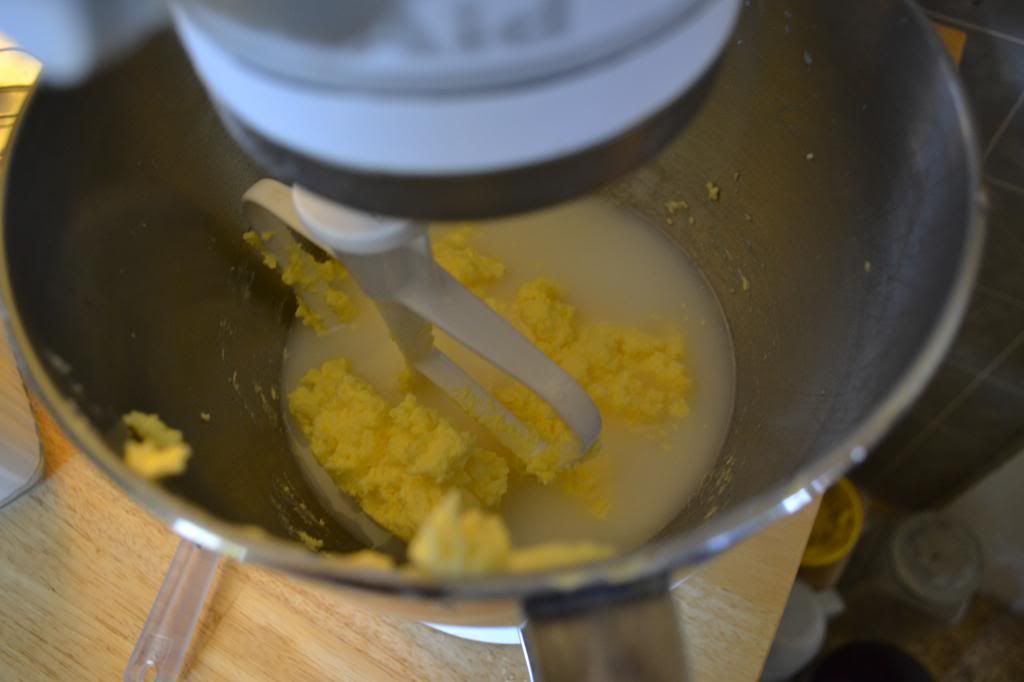
Clean the butter off of the paddle back down into the bowl, and drain. Add more ice water and mix again. I do this twice, sometimes 3 times. I suppose that if you rinsed it often enough the water would come out crystal clear, but I settle for mostly clear since I freeze the butter, and when I defrost it, we use it quickly.
Starting to look more like butter isn't it?
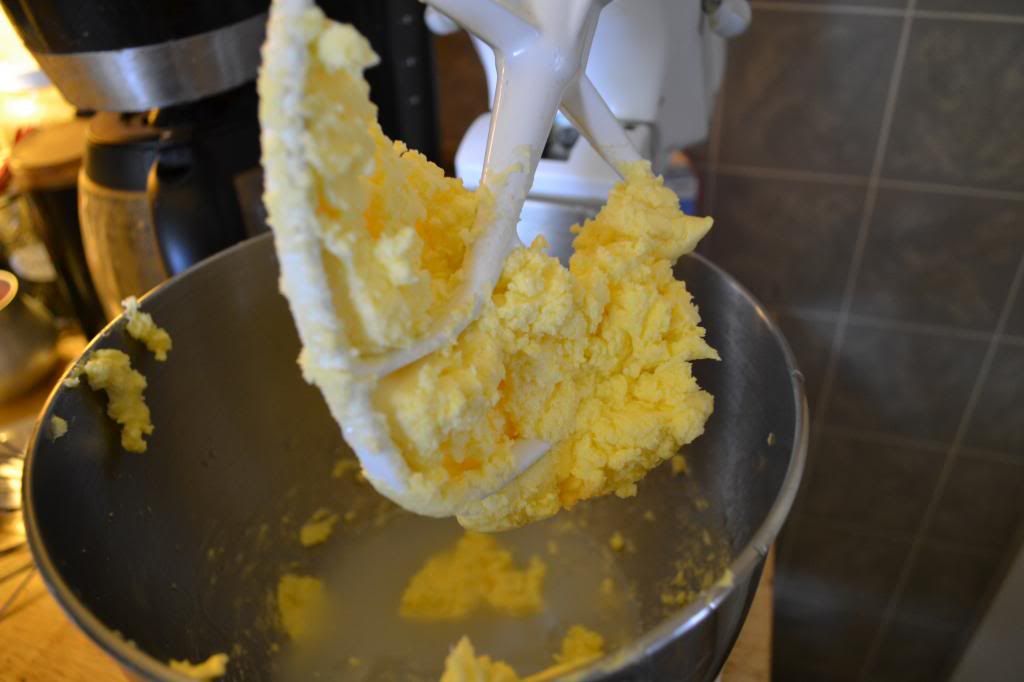
After the last rinse, I use a spatula to pull the butter together in the bottom of the bowl, while draining more of the rinse water out.

I continue to work the butter against the side of the bowl, folding it in upon itself, kneading and pressing fairly hard with the spatula. I've heard that 'professional' buttermakers use a wooden board and paddle, but this works just fine for me, especially since I work in small batches. I drain off any water that I work out. This is when you would add your salt if you chose to. I don't, preferring to salt my food as I cook it.
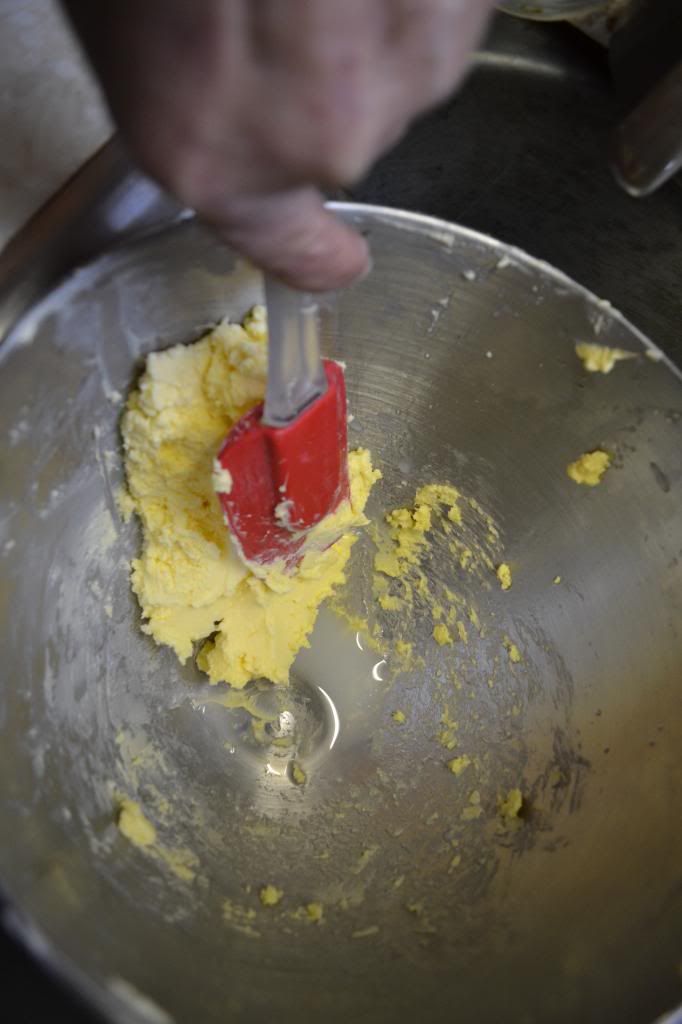
And here is the results of 1/2 gallon of cream, just over a pound of butter ready to be portioned and rolled into parchment paper, then packaged in seal-a-meal quart size bags for the freezer. I put this all together and weighed it for this photo, but I usually just package it as I go.
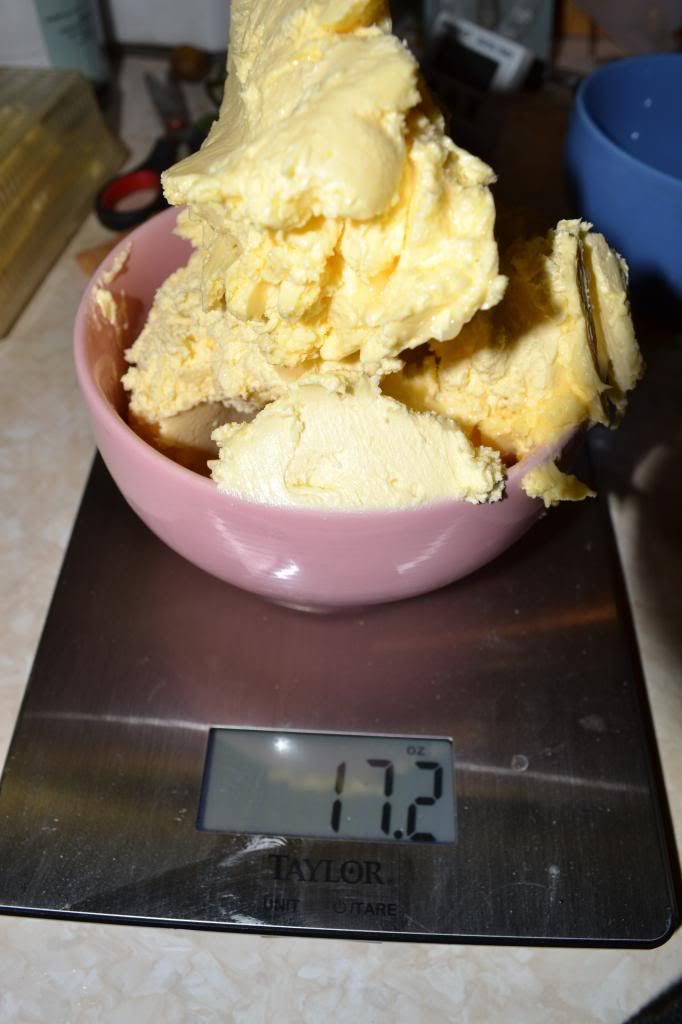
 All very good and well, but what does it LOOK like? Exactly what do I look for? What do I use? You know, all the questions that those who've been doing it for years and years have even forgotten they know because it's automatic for them.
All very good and well, but what does it LOOK like? Exactly what do I look for? What do I use? You know, all the questions that those who've been doing it for years and years have even forgotten they know because it's automatic for them. 
So I thought I'd just do a quick pictorial on what I do - it's certainly not the only way - and probably not the best way, but it works for me, I have lots of lovely butter, and just maybe someone who's just now venturing into the mysteries of cows/milk and butter making can benefit. That's my hope anyway.
So, You've milked your cow, and have cream. I personally have found that I can't make butter in the summer - it's just too warm in my house. It also works better for me if the cream is a couple of days old - which works for me since it takes about 4 days to get a gallon of cream. I just let it sit on the counter for half the day, or overnight, or some equivalent quantity of time. It's actually cool enough in my kitchen that I can leave it out for a couple of days in the fall/winter and it's still sweet. Some people like it to culture for several days - I haven't tried that yet.
So, the cream:

I just skim into these half gallon containers every day until they're full and then start the next one. I make butter when I have about a gallon worth of cream.
I tried making butter in my Kitchenaid stand mixer. I really did. Complete with tea towel over the top. Over half the time I couldn't get the cream to break - and when I did it went everywhere - the walls, the counter, the mixer, the floor. The dogs used to love it when I made butter. Me, not so much. So I switched to the blender. Eureka!

I only fill it about half full at a time. With this size blender, I make 3 batches out of a half a gallon of cream. I blend it on the lowest setting until it breaks. If it's not too noisy in your kitchen, you can actually hear the sound of the mixer change when it happens. It takes between 5 and 10 (usually closer to 5) minutes to break. If it doesn't seem to want to, you can add a dollop (I know - such a technical term
 ) of ice water into the blender. This is what it looks like when it breaks.
) of ice water into the blender. This is what it looks like when it breaks.
Doesn't look much like butter does it? but wait.....
Once it's broken carefully pour off as much of the buttermilk as you can - don't worry if you can't get it all out. There are, I suppose all sorts of fancy ways to do it, but I either use the lid or my hand to hold the butter back while I'm pouring. I then dump the butter into the bowl of my stand mixer. I add (and this is really important) a couple of cups of ice water. Not cold water, not refrigerated water, but water that's actually had ice cubes added to it. I don't put the cubes in however! I put it on the mixer with the paddle attachment and turn it on low speed for a couple of minutes. Don't however, when you go to turn it off, do what I did just today, and go the wrong way with the switch or your dog's will love you again - I promise
 .
. 
Clean the butter off of the paddle back down into the bowl, and drain. Add more ice water and mix again. I do this twice, sometimes 3 times. I suppose that if you rinsed it often enough the water would come out crystal clear, but I settle for mostly clear since I freeze the butter, and when I defrost it, we use it quickly.
Starting to look more like butter isn't it?

After the last rinse, I use a spatula to pull the butter together in the bottom of the bowl, while draining more of the rinse water out.

I continue to work the butter against the side of the bowl, folding it in upon itself, kneading and pressing fairly hard with the spatula. I've heard that 'professional' buttermakers use a wooden board and paddle, but this works just fine for me, especially since I work in small batches. I drain off any water that I work out. This is when you would add your salt if you chose to. I don't, preferring to salt my food as I cook it.

And here is the results of 1/2 gallon of cream, just over a pound of butter ready to be portioned and rolled into parchment paper, then packaged in seal-a-meal quart size bags for the freezer. I put this all together and weighed it for this photo, but I usually just package it as I go.







